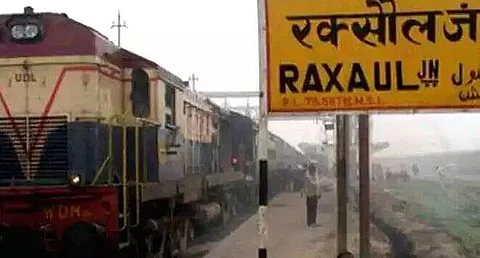
- Home
- Live Blog
- Breaking News
- Top Headlines
- Cities
- NE News
- Sentinel Media
- Sports
- Education
- Jobs

NEW DELHI: The contest between India and China for strategic influence in the Himalayas has escalated with authorities in Nepal agreeing to fast-track a rail connection from their capital Kathmandu to the Indian mainland. The decision follows China's energetic effort to link the Nepalese capital with Tibet.
Analysts say that India's initiative has strong security connotations. By connecting Nepal with India along tracks which are of a different gauge, New Delhi has prevented China to bring its railway, and in the worst-case scenario, its troops and equipment, close to the Indian border. Chinese rail tracks follow standard gauge, which are of 1,435 mm wide. On the contrary, Indian broad-gauge tracks have width of 1,676 mm.
After striking a rough patch that included a territorial dispute and a cartographic clash, India-Nepal ties have been re-booted following a string of high-profile visiting include a trip in October to Kathmandu by India's spy Chief Samant Goel. India's army chief, Manoj Mukund Naravane and foreign secretary Harsh Vardhan Shringla followed up on Goel's trip. Nepalese foreign minister Pradip Gyawali is now set to visit New Delhi to add concrete substance to the re-energised relationship.
After stalling for an extended period, the Nepalese authorities have permitted India's Konkan Railway Corporation Limited to carry out a Detailed Project Report (DPR) to connect Kathmandu with Raxaul, according to the Nepalese website Ratopati.com.
Raxaul on the India-Nepal border is the only Indian city that is connected across the border to Nepal at Birjung. Raxaul is Nepal's gateway to India, as it connected by rail with New Delhi and Kolkata, providing a vast hinterland.
The website cited Rabindranath Shrestha, Secretary at the Ministry of Physical Infrastructure and Transport in Nepal as saying that, India had sought formal permission from the Government of Nepal last August to proceed with the DPR and construction of the railway. According to Secretary Shrestha, the Ministry of Physical Infrastructure and Transport has already sent a letter to India approving the DPR and construction work along with its opinion.
The total length of the rail line is expected to be 136 kilometres, out of which 42 kilometres will pass through a tunnel. It is expected to cost about three trillion Nepali rupees.
Nepal and India had signed an agreement to conduct a feasibility study of the Kathmandu-Rexaul rail link during the 4th BIMSTEC Summit held at Kathmandu in 2018.
BIMSTEC is a vehicle for substantiating India's Act East policy, which essentially aims at reiving New Delhi's historical links in the Indo-Pacific region, with the 10-nation Association of South East Asian Nations and the island territories in the Pacific, with a strong Indian diaspora population, at its heart.
Caught in the Great Game for geopolitical influence in between India and China, Nepal had travelled a considerable distance in the forging connectivity with China via Tibet as well.
Though the aspiration to build a railway to Kathmandu dates back to the era of Mao Zedong, the founding father of the People's Republic of China (PRC), it acquired a new life under the Nepal's communist government.
The idea of extending the railway from Kyirong in Tibet to Kathmandu was discussed in 2008 when Pushpa Kamal Dahal "Prachanda" visited Beijing as the Prime Minister of Nepal. India's blockade of Nepal in 2015, further added urgency to the undertaking. The trans-Himalayan project, is estimated to cost $2.75 billion. The undertaking falls within the overarching framework of trans-Himalayan Multi-Dimensional Connectivity Network. (IANS)